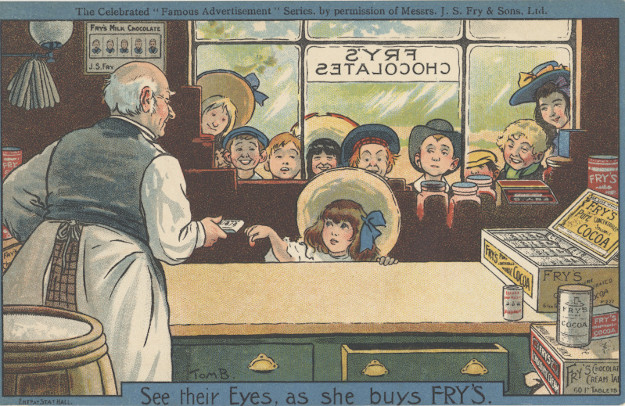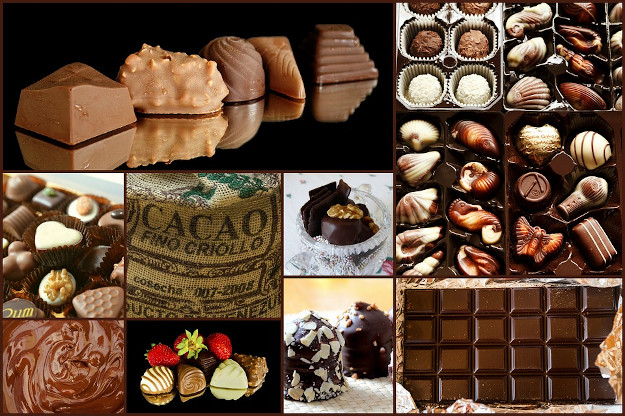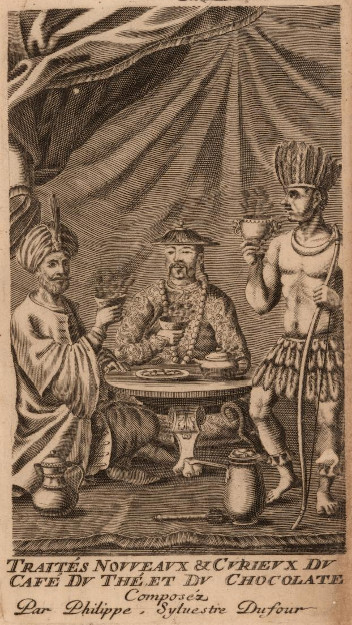The History of Chocolate as Medicine

Chocolate has not always been the common confectionary we experience today. When it first arrived from the Americas into Europe in the 17th century, it was a rare and mysterious substance, thought of more as a drug than as food. Christine Jones traces the history and literature of its reception.
In the 17th century, Europeans who had not traveled overseas tasted coffee, hot chocolate, and tea for the very first time. For this brand new clientele, the brews of foreign beans and leaves carried within them the wonder and danger of faraway lands. They were classified at first not as food, but as drugs — pleasant-tasting, with recommended dosages prescribed by pharmacists and physicians, and dangerous when self-administered.
As they warmed to the use and abuse of hot beverages, Europeans frequently experienced moral and physical confusion brought on by frothy pungency, unpredictable effects, and even (rumor had it) fatality. Madame de Sévigné, marquise and diarist of court life, famously cautioned her daughter about chocolate in a letter when its effects still inspired awe tinged with fear: “And what do we make of chocolate? Are you not afraid that it will burn your blood? Could it be that these miraculous effects mask some kind of inferno [in the body]?”
These mischievously potent drugs were met with widespread curiosity and concern. In response, a written tradition of treatises was born over the course of the 17th and 18th centuries. Physicians and tradesmen who claimed knowledge of fields from pharmacology to etiquette proclaimed the many health benefits of hot drinks or issued impassioned warnings about their abuse. The resulting textual tradition documents how the tonics were depicted during the first century of their hotly debated place among Europe’s delicacies.

Chocolate was the first of the three to enter the pharmaceutical annals in Europe via a medical essay published in Madrid in 1631: Curioso tratado de la naturaleza y calidad del chocolate by Antonio Colmenero de Ledesma. Colmenero’s short treatise dates from the era when Spain was the main importer of chocolate. Spain had occupied the Aztec territories since the time of Cortés in the 1540s — the first Spanish-language description of chocolate dates from the 1552 — whereas the British and French were only beginning to establish a colonial presence in the Caribbean and South America during the 1620s and 30s. Having acquired a degree in medicine and served a Jesuit mission in the colonies, Colmenero was as close as one could come to a European expert on the pharmaceutical qualities of the cacao bean. Classified as medical literature in libraries today, Colmenero’s work introduced chocolate to Europe as a drug by appealing to the science of the humors, or essential bodily fluids.
“Humoralism,” a theory of health and illness inherited from Hippocrates and Galen, was still influential in 1630. It held that the body was composed of four essential liquids: black bile, blood, yellow bile, and phlegm. Each humor echoed one of the four elements of nature—earth, air, fire, and water—and exhibited particular properties that changed the body’s disposition: black bile was cold and dry, blood was hot and wet, yellow bile felt hot and dry, and phlegm made the body cold and wet. Balanced together, they maintained the healthy functioning of an organism. When the balance among them tipped and one occurred in excess, it produced symptoms of what we now call “disease” in the body. While common European pharmaceuticals had long been classified as essentially cooling or heating, cacao presented both hot and cold characteristics. Later treatises faced the same conundrum regarding coffee. Depending on how it was administered/ingested, hot chocolate’s curative effects also crisscrossed the humoral categories in unexpected ways.
On the surface, its combinations of effects did not make intuitive sense to Europeans, and in practice, threatened to wreak havoc among the self-medicated, à la Madame de Sévigné. By applying the dominant theory of the body to chocolate’s uncommon powers — was it sorcery, magic, alchemy? — Colmenero endeavored to make its mystery at least debatable in terms readily accessible across the countries of Western Europe. Because Colmenero was a doctor and surgeon who was said to have traveled to the West Indies, his Tratado was received as medical lore and remained an important reference throughout the early history of writing on hot beverages. It also supplied the very first recipe for hot chocolate on the Continent (featured below) to the delight of the less learned who encountered his expertise in a mug.
Both England and France imported Colmenero’s wisdom along with the cacao beans they sourced from the American colonies and each country exploited it as a powerful marketing tool. The very first translation of the Tratado was published in English by army captain James Wadsworth, whose travels to Spain had introduced him to the wonders of the cacao beverage: A Curious Treatise of The Nature and Quality of Chocolate. Written in Spanish by Antonio Colmenero, Doctor in Physicke and Chirurgery. And put into English by Don Diego de Vades-forte (1640). Wadsworth published it under the feisty pseudonym Don Diego de Vades-forte, which may well be a metaphor for the drink: vādēs forte is Latin for “you will go” and “strong one.”

Whatever the source of the name, the Latin offers the modern reader a good sense of the reputation with which chocolate entered British culture. That said, aside from an equally feisty introduction, Vades-forte/Wadsworth claims none of the writing or the knowledge therein as his own. By rendering Colmenero’s expertise under a pseudonym that gave him credibility as a translator of Spanish, Wadsworth preserved the exotic flavor of the drink he offered his countrymen. His translation was popular enough to be republished in 1652 under a title that speaks more clearly to the British colonial experience in America: Chocolate: Or, an Indian Drinke, by the Wise and Moderate Use Whereof, Health is Preserved, Sicknesse Diverted, and Cured, Especially the Plague of the Guts. It was this later edition that became the standard translation for referencing Colmenero in subsequent English-language treatises.
While the treatise itself takes up foreign knowledge, Wadsworth’s original introductions directly address their new audience in familiar terms. His introduction to the 1652 edition pitches the drink as a cure-all for British consumers, promising help to “every Individuall Man and Woman, Learn’d, or Unlearn’d, Honest, or Dishonest”, who could afford chocolate’s “reasonable rates”. The benefits of ingesting chocolate swirl inventively around the promises of bodily repair and vigor:
The vertues thereof are no lesse various, then Admirable. For, besides that it preserves Health, and makes such as drink it often, Fat, and Corpulent, faire and Amiable, it vehemently Incites to Venus, and causeth Conception in women, hastens and facilitates their Delivery: It is an excellent help to Digestion, it cures Consumptions, and the Cough of the Lungs, the New Disease, or Plague of the Guts, and other Fluxes, the Green Sicknesse, Jaundise, and all manner of Inflamations, Opilations, and Obstructions. It quite takes away the Morphew [discolored skin], Cleanseth the Teeth, and sweetneth the Breath, Provokes Urine, Cures the Stone, and strangury [urinary infection], Expells Poison, and preserves from all infectious Diseases. But I shall not assume to enumerate all the vertues of this Confection: for that were Impossible, every day producing New and Admirable effects in such as drinke it (sig. A4r).
As much as Wadsworth’s translation anchored its knowledge in Colmenero’s firsthand medical testimony, the litany of diseases that make the case for taking the chocolate cure in the preface speak directly to threats to the body in England around 1650. In a century of dirty cities, plagues (which peaked in 1665), and terrible infant mortality rates, the medical need for chocolate must have seemed acute. Chocolate’s seemingly endless applications provided a brilliant marketing strategy for anyone who stood to benefit from the trade. At the same time, creating a British dependence on the drug served to justify the country’s colonial presence in the Caribbean, something scholars of the transatlantic conquest have not failed to point out.

Not surprisingly with a drug from an “exotic” colonial territory known for its natural ways and steamy climate, sexual arousal — inciting to Venus — tops the list of ways in which chocolate from the West Indies would fortify the British subject. Colmenero fed Wadsworth the compelling argument about increased rates of conception and ease of birth, but the latter poetically combined that news with the promise that drinking a lot of hot chocolate will make anyone “faire and amiable,” a precondition, it seems, to chocolate’s working its magical generative effects on the womb. If pleasure and parenthood were not enough, it tackles everything from coughing to bad teeth. In short, chocolate would prove stronger, claims the introduction, than any hazard or resistant lover life might throw a Londoner’s way.
By the time the French came around to capitalizing on the chocolate drug two decades later, exoticism and fashionability were more important branding criteria for chocolate than its medical application. Circa 1670, self-described French merchant-tradesman Philippe Sylvestre Dufour published Usage du caphé, du thé, et du chocolate (1671). Dufour, “from the oven,” may be another witty pseudonym (some speculate for physician and archeologist Jacob Spon, whom others claim was Dufour’s friend), as the drinks were served hot.
What we do know is that the author claims in his introduction to work as a pharmacist whose “commercial ties make him more knowledgeable than a learned man could ever be through intellectual contemplation.” Certainly he read avidly enough to discover a collection of international writers who had pontificated on the merits of coffee, hot chocolate, and tea. Claiming to translate them all himself, he took the unprecedented step of binding them together into one volume. He placed a poorly-known 1643 French translation of Colmenero by René Moreau alongside articles on coffee and tea derived from writings by a number of French and Dutch diplomats, as well as Jesuit missionaries.
The Usage thus gathered the world’s hot beverages under a single title. What’s more, the physical binding of the drugs in one volume echoed “the strong connection these drinks have to one another,” a main theme in the new introduction for the 1685 edition. Both in their preparation by boiling and in their physiological effects, drugs from three different corners of the earth behave in a strikingly similar fashion. That disparate world cultures make similar use of steeped tonics in medicine and ritual gave Dufour enough insight to deduce that they indeed form a pharmacological category unto themselves.

Raw materials from Arabia, America, and Asia thus entered the French medical literature as a new drug group. Dufour did not have the language of caffeine, but grasped that their common denominator is an ability to stimulate and fortify. Beyond this shrewd scientific insight into the behavior of coffee, chocolate, and tea, the collected works also force the idea of cultural comparison. Dufour shows that these widely dispersed lands with vastly different climates, flora, fauna, peoples, and languages, nevertheless share the cultural practice of boiling stimulants for medicinal purposes. From its binding to its title, Usage du caphé, du thé, et du chocolate, Dufour’s treatise uproots the drinks from their native lands and showcases their relationship. As his title orders the beverages, it offers a basic chronology of the caffeine trades as they developed in France during the 17th century: Arabia, then Asia, and finally the Americas.
If the idea of a small world seems obvious now, it was not then. Since the Age of Discovery, it had been commonplace to depict the world as a wide rectangle with each of the Four Continents at an angle: Europe, Africa, the Americas, and Asia. Early visual traditions represented peoples of these lands racially, painted with different colored skin, or allegorically, flanked with elephants, hunting bows, and parasols.
A frontispiece added to Dufour’s 1685 edition participates in the visual tradition of the continents but does not follow the same logic of depicting difference. Instead, it follows the logic of the treatise: to relate the global areas associated with coffee, tea, and chocolate through their similar habits. Accordingly, the frontispiece pictures men who are racialized and dressed to evoke the Middle East, Asia, and Mesoamerica sitting in a room around a table enjoying a drink together. The world suddenly looked quite small.
This is an excerpt from When Chocolate was Medicine: Colmenero, Wadsworth, and Dufour by Christine A. Jones, originally published in the Public Domain Review under a Creative Commons license. If you wish to reuse it please see: https://publicdomainreview.org/legal.
Author Bio:
Christine A. Jones is associate professor of French and Comparative Literary and Cultural Studies at the University of Utah. A specialist of early-modern genres and trades, she is the author of Shapely Bodies: The Image of Porcelain in Eighteenth-Century France (University of Delaware, 2013) and currently researching the early European print reception of chocolate, coffee, and tea.
Image Sources:
PxHere (Creative Commons)
Highbrow Magazine






























































































































































































































































































































